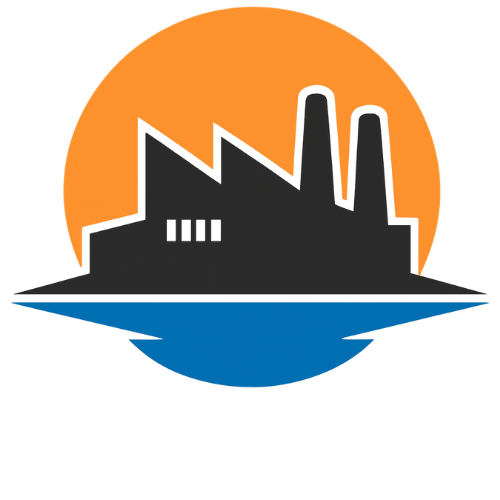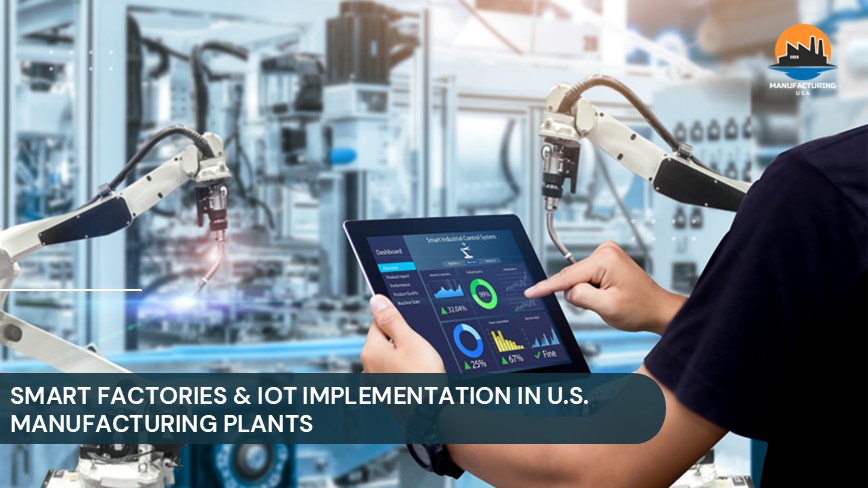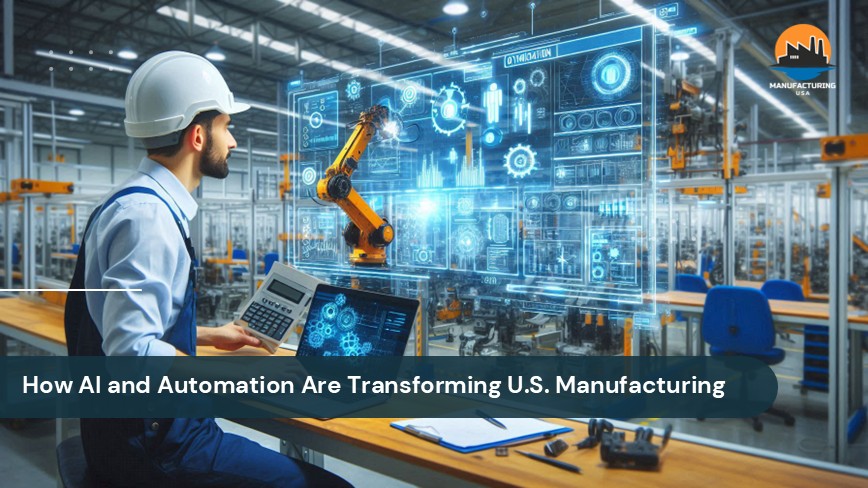The United States manufacturing sector is presently undergoing a fundamental transformation because of the integration of smart factory technologies and the Industrial Internet of Things (IIoT). The growing adoption of industry 4.0 principles is driving growth in the US smart factory market. Between 2025 and 2033, it will rise at a compound annual growth rate (CAGR) of 11.5%. Production systems are changing as a result of the digital revolution, giving manufacturers access to connected devices, artificial intelligence (AI), and data-driven decision-making that allow them to attain previously unheard-of levels of operational efficiency, quality control, and competitive advantage.
Understanding Smart Factories and IoT in Manufacturing
Smart factories represent fully digitized and connected production facilities, which leverage innovative technologies including robotics, AI, data analytics and IoT to optimize manufacturing processes autonomously. These facilities employ networked machinery, sensors, and production systems that gather and distribute real-time data throughout the value chain, enabling manufacturers to make informed decisions that enhance productivity, reduce waste, and improve product quality.
The Industrial Internet of Things (IIoT) serves as the technological foundation of smart manufacturing, connecting machines, devices, and systems to the internet for seamless data collection and analysis. IIoT technologies enable real-time monitoring, predictive maintenance, quality assurance, equipment optimization, warehouse operations, inventory management, and other critical manufacturing functions that drive operational excellence.
As per a 2024 report from the National Institute of Standards and Technology (NIST), 67% of US manufacturers are planning to invest in IoT, AI, and digital twin technologies for real-time monitoring and predictive maintenance over the next five years. This substantial investment commitment underscores the strategic importance manufacturers place on digital transformation initiatives to remain competitive in an increasingly automated global marketplace.
Key Competitive Advantages
Several factors contribute to US leadership in smart factory implementation:
- Advanced Technological Infrastructure: The United States possesses world-class digital infrastructure, high-speed connectivity networks, and cloud computing capabilities that facilitate the deployment of sophisticated IoT and automation technologies.
- Skilled Technical Workforce: American manufacturers benefit from access to highly trained engineers, data scientists, and technical professionals capable of implementing and managing complex smart factory systems.
- Government Support and Funding: Federal initiatives demonstrate substantial commitment to manufacturing modernization. For example, under the Bipartisan Infrastructure Law, the U.S. Department of Energy announced approximately $13 million in funding to help state-funded universities and technical and community colleges increase access to high-performance computing resources and smart manufacturing technologies for domestic manufacturing companies. Additionally, in July 2024, a $33 Million funding opportunity was announced by the U.S. Department of Energy’s Advanced Materials and Manufacturing Technologies Office to promote the development of smart manufacturing technologies and procedures that are crucial to the country’s clean energy transition. These investments signal strong governmental recognition of smart manufacturing’s strategic importance to economic competitiveness and national security.
Industry Adoption Patterns
Manufacturing executives demonstrate significant confidence in smart factory solutions as primary drivers of competitiveness over the next five years, with 86% of U.S. manufacturers considering smart factories as key to competition by 2025, according to industry research. However, current implementation reveals significant growth opportunities, as only 16% of manufacturers currently have real-time visibility into their operations, indicating substantial room for market expansion and technology adoption.
Recent Strategic Developments
- Siemens AG: In November 2024, Siemens announced the acquisition of U.S. industrial software company Altair Engineering for $10.6 Billion, significantly expanding its industrial software and artificial intelligence capabilities. This strategic acquisition is expected to add approximately €600 Million to Siemens’ digital business revenue and strengthen its position in AI-driven industrial software and simulation tools. Siemens continues to drive innovation through its MindSphere platform, a cloud-based IoT solution that enables real-time monitoring, predictive maintenance, and data-driven optimization for smart factories.
- Microsoft Corporation: In November 2024, Microsoft released Azure IoT Operations, its next-generation IoT service designed for managing IoT data across cloud and edge environments. This platform enables manufacturers to implement comprehensive IoT strategies with enhanced data integration, analytics, and operational intelligence capabilities.
Industry Collaboration Initiatives
- In October 2024, Cognizant collaborated with Amazon Web Services to boost smart manufacturing across sectors like automotive, health sciences, and consumer goods by leveraging cloud, IoT, and AI for faster digital transformation and process optimization.
- In November 2024, CESMII joined with NIST’s Manufacturing Extension Partnership to help small and mid-sized manufacturers adopt smart technologies through training, education, and integration programs aimed at improving U.S. manufacturing productivity and competitiveness.
Emerging Trends Reshaping Manufacturing
- Artificial Intelligence and Machine Learning
AI is transforming manufacturing through predictive maintenance, quality control, production optimization, and supply chain management. Manufacturers use AI to analyze production data, detect patterns, predict failures, and adjust schedules in real time.
- Digital Twin Technology
Digital twins simulate production systems to test and refine processes before implementation, reducing downtime and risk. In 2024, the U.S. Department of Commerce announced $285 million for SMART USA, a Manufacturing USA institute advancing digital twin technology for semiconductor production.
- Predictive Maintenance
IoT-based predictive maintenance monitors equipment health to prevent failures, extend lifespan, and improve scheduling. Smart factory users report up to 12% higher labor productivity, easing workforce shortages and boosting efficiency.
- Cybersecurity and Supply Chain Resilience
As connectivity grows, cybersecurity has become vital. Manufacturing ranks among the top three industries targeted by cyberattacks. The NIST 2024 budget added $4 million to strengthen supply chain security and safeguard industrial data.
- Sustainability and Energy Efficiency
Smart technologies reduce energy use and waste through real-time monitoring and AI analytics. Tesla’s Gigafactories use AI-controlled HVAC and Hygrometric Control Logic, saving 17,000 MWh annually by fine-tuning temperature and humidity.
Strategic Recommendations for Market Entry and Expansion
For Corporate Strategy Teams
- Digital Roadmaps: Create clear strategies linking smart factory investments to business goals, focusing on high-impact use cases, priorities, and measurable outcomes.
- Workforce Development: Build skilled teams through training, academic partnerships, and targeted hiring in data science, automation, and digital manufacturing.
- Interoperability: Choose technologies that follow industry standards and enable seamless data and system integration across operations.
For Business Development and Marketing Managers
- High-Growth Industries: Focus on automotive, aerospace, electronics, and pharmaceuticals—sectors with strong demand for smart factory solutions that enhance quality, compliance, supply chain visibility, and flexibility.
- ROI Focus: Typical investments range from $2–10 million (3–5% of annual revenue) with payback in 18–36 months. Leading plants achieve 15–25% annual ROI through higher productivity and quality.
- Government Incentives: Pursue funding through programs like the State Manufacturing Leadership Program, advanced manufacturing grants, and partnerships with national labs or Manufacturing USA institutes.
For Investors and Venture Capital Firms
- Software and Analytics: High-growth opportunities lie in platforms for analytics, predictive maintenance, digital twins, and production optimization, offering strong margins and value creation.
- Cybersecurity: Expanding connectivity drives demand for industrial cybersecurity solutions with solid growth potential and strategic importance.
- SME Market: Beyond large enterprises, small and mid-sized manufacturers offer major growth potential as technology costs drop and government programs increase access.
For Consulting Firms
- Industry Expertise: Smart manufacturing consulting demands sector-specific knowledge of regulations and operations. Firms should specialize in key industries instead of offering generic digital solutions.
- Technology Partnerships: Success depends on strong ties with leading vendors, integrators, and solution providers to ensure complete implementation support.
- Continuous Improvement: Smart factory optimization is ongoing. Firms should provide monitoring, analytics, and continuous enhancement services to sustain long-term value.
Addressing Implementation Challenges
- High Capital Costs: Smart factory upgrades need large upfront spending on hardware, software, and infrastructure. A phased rollout focusing on quick-return projects can generate early gains to fund later stages.
- Skills Gap: Limited expertise in IoT systems hinders adoption. Companies should invest in training, partner with institutions, and combine internal skill-building with external specialists.
- Integration Challenges: Legacy systems and incompatible data formats complicate implementation. Using open standards, middleware, and experienced integrators helps streamline integration.
- Change Management: Transformation demands cultural shifts, not just technology. Clear communication, employee engagement, and incentives encourage adoption and improvement.
Future Outlook and Market Projections
The U.S. smart factory and IoT manufacturing market is set for strong growth through 2033, fueled by rapid innovation, rising competition, policy support, and proven returns from early adopters. The combination of AI, 5G, edge computing, and advanced robotics will expand capabilities and speed up adoption.
Smart factory investment is becoming essential for manufacturers competing globally. Those delaying digital transformation risk losing ground to rivals using automation and data-driven systems to boost efficiency and reduce costs. Integrating sustainability with smart manufacturing will further drive growth, as companies seek to cut emissions and improve profitability through better control and optimization.
Conclusion
Smart factories and IoT are driving the biggest shift in U.S. manufacturing since the assembly line. With valuations set to more than double in five years and strong government backing, this transformation is redefining competitiveness across sectors.
Manufacturers that invest in the right technologies, develop skilled teams, and promote continuous improvement will gain lasting advantage in an automated, connected, data-driven environment. The question now is not whether to adopt smart factory systems, but how quickly and effectively companies can execute digital transformation to unlock their full benefits.
Choose Us, As We Offer Unmatched Expertise and Core Services
- Market Research: Gain clear insights into U.S. smart factory adoption, technology trends, and competition through actionable, data-driven research.
- Growth Forecasting: Track key trends like Industry 4.0, AI, digital twins, and 5G in manufacturing sectors and regions.
- Competitive Benchmarking: Evaluate competitors, technology providers, product pipelines, and major innovations in automation and IoT systems.
- Policy Advisory: Understand regulations, funding, cybersecurity, and standards shaping smart manufacturing.
- Custom Consulting: Get tailored insights for technology adoption, investments, acquisitions, or market entry strategies.




